U.S. stocks struggled in early trading as investors digested the possibility of more aggressive monetary tightening by the Federal Reserve and monitored the war in Ukraine.
The S&P 500 ticked down 0.2% Thursday, a day after the benchmark gauge fell 1%. The selloff Wednesday followed the release of minutes from the Fed that showed central bankers considered raising rates by a half-percentage point at their March meeting, higher than the quarter-point increase with which they proceeded.
The technology-focused Nasdaq Composite Index dropped less than 0.1%, while the Dow Jones Industrial Average fell 0.7%, or about 254 points.
“I guess we have a little bit of a hangover from the FOMC minutes,” said Oanda analyst Edward Moya. Investors are trying to get a better sense of where the economy goes and how that affects the Fed’s monetary policy, he said.
Markets
In Treasury markets, the yield on the 10-year U.S. Treasury note traded around 2.631%, up from 2.606% on Wednesday. It continues to hover around its highest level in three years.
An earlier pullback in stock futures had suggested that the recent downturn in U.S. indexes could extend into Thursday, as investors sell riskier assets in anticipation of a more hawkish Federal Reserve. On Tuesday, Fed governor Lael Brainard—a strong advocate last year against prematurely pulling back stimulus—rattled investors when she said the central bank was committed to taking steps that will reduce inflation this year. Those jitters continued Wednesday after the Fed’s minutes were released.
Before this week, the U.S. stock market had been in the midst of a brisk rally, helping indexes erase many of the losses notched in 2022. The rebound, which began in mid-March, seemed to defy a slew of circulating issues including the war in Ukraine, rising Covid-19 cases in China and soaring inflation that threatens to worsen supply-chain snarls. Even after losing 2.2% in the last two sessions, the S&P 500 is now down just 6% for 2022, based on Wednesday’s closing prices, a comeback from its more than 12% loss at its low this year.
Investors and analysts say there is plenty of potential for the U.S. stock market to keep climbing higher, even amid choppiness in recent sessions.
“I think investors are viewing the markets and saying, ‘You know what, we still have a strong economy and a recession is far from inevitable, even with all these rate hikes, and there’s a very strong labor market,’” said Craig Erlam, a senior market analyst at Oanda. “There is plenty of downside risk within that… But there seems to be a lot of resilience.”

Analysts say the recent steadying in some commodities prices has aided the stock market’s performance. U.S. crude oil rose 0.4% Thursday to $96.60 a barrel. That is slightly higher than before Russia’s invasion of Ukraine but down significantly from the nearly $130 price reached last month.
On the economic front, fresh data Thursday showed that new applications for U.S. unemployment benefits last week fell to a near 54-year low. Initial jobless claims, a proxy for layoffs, fell to 166,000 during the week ending April 2, compared with a revised 171,000 the prior week, the Labor Department said. Economists surveyed by The Wall Street Journal expected 200,000 new claims.
Next week, first-quarter earnings season will kick off. Many investors say results will likely have a heavy hand in swaying the next phase of the U.S. stock market. Analysts expect earnings for S&P 500 companies to have grown 4.6% during the period compared with a year earlier, FactSet data show.
In individual stocks, shares of HP surged 16% after Warren Buffett’s Berkshire Hathaway disclosed in a filing Wednesday that it has built a stake of more than 11% in the computer-and-printer maker. The holding was worth more than $4.2 billion, based on HP’s closing price on Wednesday. Berkshire’s Class B shares ticked down 0.5%.
Twitter fell 2.1% as investors continued to digest the implications of Tesla chief executive Elon Musk’s stake in the social-media company and his appointment to its board. Shares of Tesla added 2.1% after the opening bell.

In Europe, the pan-continental Stoxx Europe 600 added 0.2%. Healthcare and transportation stocks were among those that pushed the index higher. Ryanair Holdings jumped 6.1% and easyJet added 1.8%.
Shares of Shell fell 1.8% after the energy giant warned of an up to $5 billion hit in the first quarter related to its decision to exit its joint ventures with Russian energy giant Gazprom following Russia’s invasion of Ukraine.
In Asia, indexes fell. Hong Kong’s Hang Seng lost 1.2%, while in mainland China, the Shanghai Composite Index fell 1.4%. Japan’s Nikkei 225 declined 1.7%.
Source: here




